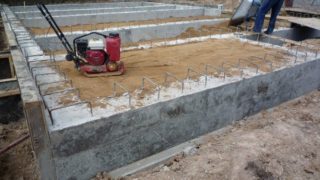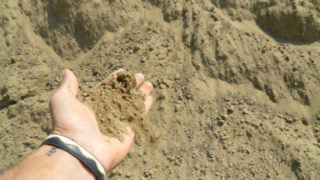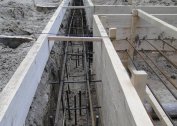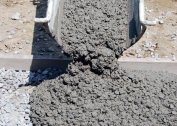Backfilling is carried out after the concrete, which forms the foundation of the foundation, completely hardens. Empty spaces often appear around the perimeter of the structure. To protect the soil from overmoistening, which can violate the integrity of the base, a gap is filled with a filler.
Rules for backfilling of the sinuses of the pit and the importance of the operation
Backfill of the pit sinuses is regulated by SNIP 3.02.01-87. This document describes the material requirements for filling the trench gaps and the sequence of work. The target moisture and density parameters to which the loaded soil should meet vary depending on its type. Powerful vibrators are used to seal during backfilling of the pit sinuses.
Filler must be prepared in advance. It should be as uniform as possible. It is advisable to remove foreign bodies - pebbles, branches, pieces of bark and similar inclusions. Narrow sinuses should be filled with materials as less prone to shrinkage as gravel or a mixture of sand and gravel. In no case should you use a fertile layer - it contains plant mass and organic compounds that will rot over time. Backfilling is prohibited when watering the walls and bottom of the trench. Moisture must be removed. To this end, you can equip a contour channel for drainage.
The construction estimate for the calculations will turn out to be more expensive, but this is the only method that helps lower the level of heaving.
The foundation of the foundation is carried out after two to three weeks after pouring concrete and mounting the base. It is important that the mixture has time to harden. It is not worth doing a backfill foundation before 2 weeks have passed - this will load the concrete, which can lead to the destruction of the structure. In addition, during the work, it is possible to inflict damage to the material that is not completely frozen. Water entering the cracks will contribute to the destruction of the base and rust reinforcing bars. The formwork frame must be dismantled by the start of work.
The asleep trench needs to be cleaned from garbage and accidentally caught foreign objects. Then the soil moisture is estimated. If the soil is prone to heaving, the optimal indicator is 12-15%. In heavy soils, a higher water content is allowed (up to 20%). Both dry soil and waterlogging are harmful. If necessary, the soil is brought to the desired condition. Then a layer of sand (or its mixture with gravel) is poured 0.3 m high. After this, you can proceed to backfilling the foundation.
The purpose of the procedure is to create a bonding layer between the concrete strip and the natural local soil. In addition, protection of nearby soil layers from erosion by water is provided. This is necessary, since when waterlogging the soil located next to the base, there is a threat of violation of the integrity of the foundation, deterioration of its performance and reduced service time.
Backfill compaction technology
To organize the seal will require special technical equipment. It is definitely not recommended to tamper backfill manually - the process will take a lot of time and it will be difficult to achieve the desired density. A layered scheme of work is used. Ram the embankment until it responds to this process. The thickness of one layer depends on what material is used:
- for clay soils the value is minimal: the layer should not be thicker than half a meter;
- when using sandy loam and loamy soils, the highest value is 0.6 m;
- sand fillings can reach 0.7 m.
The fresh layer is treated with a trench equalizer and rammer. The force during primary processing should not exceed 0.7 of the norm for the material involved. The following passages should overlap the previous one by ¼ or 1/3 of the width so that the vibrator plate has enough time for compaction. The upper layers are stacked at high pressure. When erecting large (including two-story) buildings, a vibratory roller is suitable for compaction of materials.
When the trench is filled up, you need to organize an inclined blind area to divert water from the foundation. Waterflooding of nearby soil destructively affects the established base.
Inside
If the homeowner does not plan to use the basement, clay is filled inward under the concrete screed, which protects against the penetration of groundwater. Having laid out a layer of 0.3 m, it must be tamped. Then make a sand embankment, compact, slightly moisturize. A waterproofing layer of roofing material is laid out on top. To reduce heat loss, another layer of sand is poured onto which the screed is arranged.
When organizing work on the inside, you can use different types of soils, which is associated with a less pronounced temperature differences and threats of waterlogging. Do not forget about layer-by-layer compaction, as well as cleaning from foreign inclusions.
Outside
External filling is also implemented according to a layered scheme. The soil must be provided with adequate drainage. To insulate the foundation from the outside, you can use polyurethane foam or styrofoam. Expanded clay is inferior in effectiveness to these materials, moreover, it is more difficult to assemble.
The choice of material for backfilling the foundation
Different types of soils can be used. The main thing is that they comply with the norms of humidity and density. It is also very important that the filler does not change its qualities under the influence of water. To achieve the proper values of the last indicator, a special technology is used, which involves laying the material in thin layers followed by tamping of each of them.
Sand
Sand and gravel mixtures are well suited for laying in sinuses due to their excellent drainage qualities. With a well-organized blind area, this design guarantees reliable protection against heaving at low temperatures. Sanding also adds stability to the building's box. It is also important that the material is easy to tamper and keeps its density well.
The lack of sand is moisture permeability. Because of this, water accumulates in the thickness of the backfill, which creates an overload of the waterproofing layer. Moisturizing the sole degrades the bearing qualities of the soil. Correctly arranged blind area can improve the situation. The correct choice of slope and installation of waterproofing will prevent the accumulation of rain moisture. Near the blind area is also necessary to organize drainage. This will allow water to be diverted for further use on the farm (for example, to water garden and garden crops).
Gully sand is more suitable for placement in the sinuses than pure river or quarry. This is due to the content of a large number of salts and clay inclusions, providing the best tamper. Clean sand can be washed out by groundwater. Therefore, it is recommended to use it only in a mixture in half with gravel. Gully sand should not be washed - this will lead to the removal of binding particles. It only needs to be cleaned of inclusions of plant origin and other organics.
To calculate how much sand is required for work, you can use the online calculator. The formula is tailored to work with different types of backfill.You can tamp sand by slightly moistening it, if this does not harm the components of the substrate.
Clay materials
The best option is skinny clay, almost non-absorbent. If you have to deal with solid lumpy material, additives for plasticity, for example, sand (about 5%), are introduced into it. The introduction of impurities does not affect the strength and shrinkage characteristics, but it greatly simplifies tampering. The material is suitable for rocky soil, as well as for houses built in areas with low overgrown soil waters.
Clay is good in that it serves as a barrier to moisture, not passing it to the sole and protecting the latter from destructive effects. The disadvantage of this material is its tendency to heave. Under certain conditions, clay absorbs moisture. Lay the material in thin layers, subject to compulsory compaction.
The consequences of improper backfill
Failure to comply with the filling technology and requirements for fillers can contribute to leaching of the material, the accumulation of fluid in it or destructive processes in the sole. Improper organization of waterproofing also contributes to the rapid wear of the base.
You can’t use dusty soils and mixtures containing a large number of fine particles to fill the gaps - they are easily washed out by groundwater. Peat and chernozem soils are not suitable for this purpose. Mechanical impurities (including pebbles) must be removed before filling, as they can violate the integrity of the waterproofing layer. Performing the procedure in the winter is not recommended. During this period, there is a lot of moisture and ice in the soil, which negatively affects the ability to compact.
The material for backfilling must be uniform, comply with the regulated indicators of humidity and density, and not radically change its qualities from exposure to water. When performing work, you must carefully follow the established technology.






